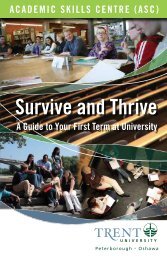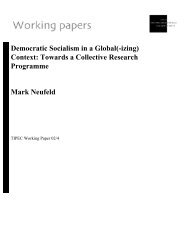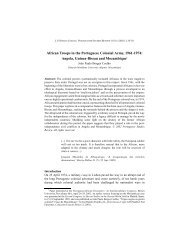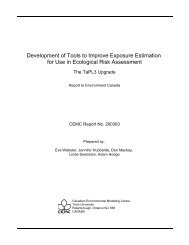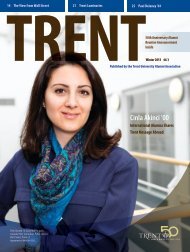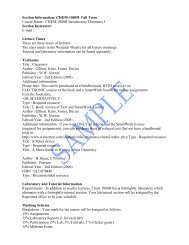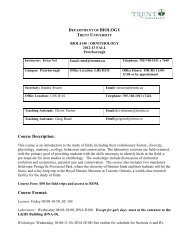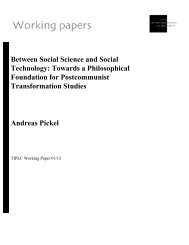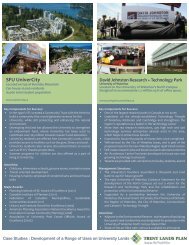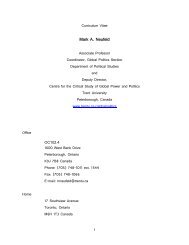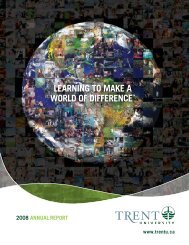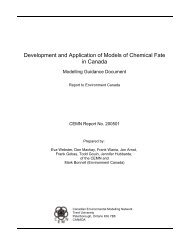AUTHOR COPY - Trent University
AUTHOR COPY - Trent University
AUTHOR COPY - Trent University
You also want an ePaper? Increase the reach of your titles
YUMPU automatically turns print PDFs into web optimized ePapers that Google loves.
Conceptualizing holism in international interdisciplinary critical perspective<br />
that is non-reductionist or dualist. Holism is sometimes spelled as wholism, to<br />
accentuate the semantic connections of this word to the word ‘whole’. In this<br />
article, the concept holistic health-care will be used interchangeably with<br />
alternative or complimentary medicine and will be defined as approaches to<br />
well-being and treatment of illness that focus on mind and body. In addition to,<br />
the term holistic health-care is used in this article to encompass both self-care<br />
and practitioner-based care. Holistic self-care encompasses practices such as<br />
yoga, meditation, Tai Chi and Chi Gung. Holistic care provided by professionals<br />
encompasses traditional Chinese medicine, ayurveda, homeopathy, botanical<br />
medicine, therapeutic massage and others.<br />
Holistic schools of thought vary from region to region, and throughout time, but<br />
have more similarities than differences. A number of principles unite them.<br />
One principle they have in common is that entities and systems in the universe,<br />
including humans, are considered part of a unified whole, which cannot be<br />
understood by the isolated examination of its separate parts (Dusek, 2006).<br />
These parts are actively interrelated. Similarly, matter is interlinked, interconnected<br />
and dynamic; it is constantly changing and it is this transformation that<br />
denotes time.<br />
Holistic worldviews do not focus exclusively on the body or organism, but on<br />
the larger world – the universe – and are often associated with spiritual or<br />
religious thought-forms. At the heart of holism, there is an awareness of the<br />
unity and mutual interrelation of all things and events. All things are seen as<br />
interdependent and inseparable. This ultimate, indivisible reality is called<br />
Brahman in Hinduism, Dharmakaya in Buddhism and Tao in Taoism. As it<br />
transcends all concepts and categories, Buddhists also call it Tathata-Suchness<br />
(Deshmukh, 2006), That Which Is, or Is-ness, the sum of all forms.<br />
In Hinduism, we find a similar emphasis: ‘a fundamental Hindu principle<br />
is one of Unity of all created things. Behind diversity, there is unity. Behind<br />
individual souls, there is the Self, one with the Divine. Not only human life but<br />
all created life including animal life is a unity. We spring from one source.<br />
Differences and divisions are unreal. The belief that we originate from one<br />
common source has ethical implications: it leads to a kinder and a gentler<br />
world’ (Goel, 2006). One of the Hindu texts, the Isa-Upanisad states: ‘[b]ut<br />
he (sic) who beholds all beings in his (sic) own Self, and his (sic) own Self in all<br />
beings, does no longer hate (vijugupsate)’ (stanza 6).<br />
These views are also echoed in other traditions. According to African holistic<br />
views, for example, the cosmos is one, a spiritual totality. Spirit is not separate<br />
from matter, as everything is connected (Asante and Mazama, 2009). In African<br />
holistic thought, all things are considered to be related through one divine force<br />
(Asante and Mazama, 2009). They are alive, giving and receiving energy, with<br />
all life and matter created for a specific purpose.<br />
<strong>AUTHOR</strong> <strong>COPY</strong><br />
r 2011 Macmillan Publishers Ltd. 1477-8211 Social Theory & Health Vol. 9, 3, 244–255<br />
245



